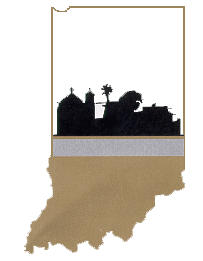 |
Indiana Farmstead Assessment for Drinking Water ProtectionMilking Center Wastewater Treatment |
 |
 |
Indiana Farmstead Assessment for Drinking Water ProtectionMilking Center Wastewater Treatment |
 |
Skip this survey if you discharge all milking center wastewater directly to a liquid manure storage facility. Use Survey 7 to assess water quality risks posed by a manure storage facility. This survey evaluates the risk to water quality posed by discharge of milking center wastewater to the soil. Circle the answer that best describes how you treat milking center wastewater. At the end of each section sum the numbers that correspond to your answers. When you have completed the survey sum each section score for the risk assessment score. For more information on treating milking center wastewater see Fact Sheet 10.
For each question, a (1) represents a higher risk to drinking water than a (3).
1. Is the milkhouse more than 50 feet from a water well?
Yes (3) No (2) 2. Is the wastewater settling tank or septic tank at least 50 feet from a well? Yes (3) No (1) If you use a settling tank prior to discharge, answer Question 3. If you use a septic tank prior to discharge answer Question 4. 3. Is the wastewater discharge area at least 500 feet from the well? Yes (3) No (1) 4. Is the septic absorption field at least 100 feet from the well? Yes (3) No (1) In Questions 5 through 9, "discharge area" refers to either a surface infiltration area or a septic absorption field. 5. How far is the discharge area from the nearest: surface water less than 100 feet (1) 100 to 200 feet (2) more than 200 feet (3) tile inlet less than 100 feet (1) 100 to 200 feet (2) more than 200 feet (3) 6. Is the discharge area downslope from: the well? Yes (3) No (2) surface water? Yes (3) No (2) tile inlet? Yes (3) No (2) 7. What is the texture of the soil in the discharge area? clay (2) loam (3) sand (1) 8. Describe the soil drainage at the discharge area. poor (2) good/moderate (3) excessive (1) 9. How deep is the soil layer above the top of the water table or fractured bedrock? less than 3 feet (1) 4 to 10 feet (2) more than 10 feet (3) Location and Site Characteristics section total ________
10. Does the wastewater settling or septic tank have any leaks?
Yes (1) No (3) 11. How many times a year do you clean out your settling or septic tank? at least 3 times (3) twice (2) once or fewer (1) Wastewater Tank Maintenance section total _________
12. What percentage of waste milk is poured down the drain?
less than 10% (3) 11 to 50% (2) more than 50% (1) 13. Do you remove manure and excess feed prior to washdown? Yes (3) No (1) 14. Is the first pipeline rinse captured and added to the barn manure? Yes (3) No (2) Milking Cleanup section total __________
Add the following totals:
Location and Site Characteristics section total ___ x 3 = ____
Wastewater Tank Maintenance section total ___ x 2 = ____
Milking Cleanup section total = ____
Survey 10 Score _____
----------------------------------------------------------------------
Low Moderate High
129 - 109 110 - 70 71 - 52
----------------------------------------------------------------------
Click here for Fact Sheet 10
Milking Center Wastewater Treatment Fact Sheet
| Reviewed 5/1/01 |
|
It is the policy of the Purdue University Cooperative Extension Service, David C. Petritz, Director, that all persons shall have equal opportunity and access to its programs and facilities without regard to race, color, sex, religion, national origin, marital status, parental status, sexual orientation, or disability. Purdue University is an Affirmative Action employer. This material may be available in alternative formats. 1-888-EXT-INFO. |